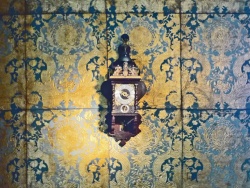Difference between revisions of "Leather wallpaper"
| (One intermediate revision by one user not shown) | |||
| Line 4: | Line 4: | ||
| − | Leather wallpapers (Peaux d'Espagne, Guadamiciles) were a popular wall ornamentation in the Baroque style, mostly made of thin [[calfskin]], [[goatskin]] or [[sheep leather]] with [[Painting on leather|paint]], as well as [[Metallic leather|silver-plated]] and [[Gold leather|gilded]] elements. They were mainly found in the dwellings of nobles and aristocrats. Leather wall coverings probably originated in Andalusia and North Africa as a Moorish invention, before becoming common throughout | + | Leather wallpapers (Peaux d'Espagne, Guadamiciles) were a popular wall ornamentation in the Baroque style, mostly made of thin [[calfskin]], [[goatskin]] or [[sheep leather]] with [[Painting on leather|paint]], as well as [[Metallic leather|silver-plated]] and [[Gold leather|gilded]] elements. They were mainly found in the dwellings of nobles and aristocrats. Leather wall coverings probably originated in Andalusia and North Africa as a Moorish invention, before becoming common throughout Spain and France. From the 18th century onwards, paper wall coverings gradually replaced leather. |
In the Moritzburg castle near Dresden in Germany, 300 years ago 60 of the 200 castle rooms were decorated with [[Carving leather|carved]], [[Embossed leather|embossed]] and [[Painting on leather|painted]] leather tapestries. Today there are only 13 rooms left. | In the Moritzburg castle near Dresden in Germany, 300 years ago 60 of the 200 castle rooms were decorated with [[Carving leather|carved]], [[Embossed leather|embossed]] and [[Painting on leather|painted]] leather tapestries. Today there are only 13 rooms left. | ||
| Line 19: | Line 19: | ||
</p> | </p> | ||
<p align=center> | <p align=center> | ||
| − | ''Leather cover and motifs of leather tapestries - seen in the German leather museum [[ | + | ''Leather cover and motifs of leather tapestries - seen in the German leather museum [[Leather museum|DLM - Deutsches Ledermuseum in Offenbach]].'' |
</p> | </p> | ||
| Line 47: | Line 47: | ||
''Leather wallpaper with [[gold leather]] (leaf silver with paintwork) in the castle Jever, Germany.''<br></p> | ''Leather wallpaper with [[gold leather]] (leaf silver with paintwork) in the castle Jever, Germany.''<br></p> | ||
<p> </p> | <p> </p> | ||
| − | |||
| − | |||
| − | |||
== Additional information == | == Additional information == | ||
Latest revision as of 19:36, 6 December 2021
Leather wallpapers (Peaux d'Espagne, Guadamiciles) were a popular wall ornamentation in the Baroque style, mostly made of thin calfskin, goatskin or sheep leather with paint, as well as silver-plated and gilded elements. They were mainly found in the dwellings of nobles and aristocrats. Leather wall coverings probably originated in Andalusia and North Africa as a Moorish invention, before becoming common throughout Spain and France. From the 18th century onwards, paper wall coverings gradually replaced leather.
In the Moritzburg castle near Dresden in Germany, 300 years ago 60 of the 200 castle rooms were decorated with carved, embossed and painted leather tapestries. Today there are only 13 rooms left.
Leather cover and motifs of leather tapestries - seen in the German leather museum DLM - Deutsches Ledermuseum in Offenbach.
Leather wallpaper in the restaurant "Waldschänke Moritzburg" in Dresden, Germany.
Leather wallpaper with gold leather (leaf silver with paintwork) in the castle Jever, Germany.
Additional information



















 a kotori web solution
a kotori web solution